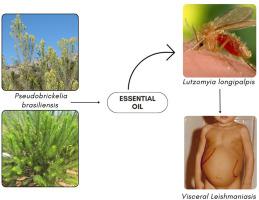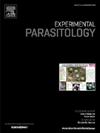巴西Pseudobrickellia brasiliensis (Spreng) R. M. King和H. Rob (Asteraceae)精油对长掌Lutzomyia longipalpis的化学成分和杀虫活性(双翅目:心梗科)
IF 1.6
4区 医学
Q3 PARASITOLOGY
引用次数: 0
摘要
在巴西,婴儿利什曼原虫主要通过沙蝇的叮咬传播,沙蝇是利什曼病的主要内脏媒介。虽然最常见的病媒控制策略是使用合成杀虫剂,但对这些产品日益增长的抗药性引发了开发新替代品的兴趣。在这种情况下,由于具有杀虫潜力的次生代谢物的多样性,植物成为一种可行的可能性。本研究旨在对巴西刺槐挥发油进行化学性质表征,并评价其对长掌松毛虫的毒性。采用Clevenger蒸馏装置从巴西青叶中提取精油,并采用气相色谱-质谱联用(GC-MS)进行化学分析。为了进行生物测定,在野外收集沙蝇,然后暴露于不同浓度的精油(2.5,5.0和10 mg mL - 1),也用于阴性和阳性对照组。在确定的时间评估死亡率。GC-MS分析鉴定出49种化合物,以单萜类、倍半萜类和二萜类为主。α-蒎烯和异双环大肾是总离子色谱相对峰面积的主要成分,分别占17.9%和13.3%。生物测定结果表明,在不同浓度下,巴西木挥发油对长掌螨均有一定的毒性,是一种很有前途的天然杀虫剂,可用于病媒防治。本文章由计算机程序翻译,如有差异,请以英文原文为准。

Chemical composition and insecticidal activity of the essential oil of Pseudobrickellia brasiliensis (Spreng) R. M. King & H. Rob (Asteraceae) on Lutzomyia longipalpis (Diptera: Psychodidae)
In Brazil, Leishmania infantum is transmitted mainly through the bite of the sand fly Lutzomyia longipalpis, the main visceral leishmaniasis (VL) vector. Although the most common vector control strategy is the application of synthetic insecticides, growing resistance to these products has sparked interest in developing new alternatives. In this context, plants emerge as a viable possibility due to the diversity of secondary metabolites with insecticidal potential. This work aimed to chemically characterize the essential oil of Pseudobrickellia brasiliensis and evaluate its toxicity on L. longipalpis. The essential oil was obtained by hydrodistillation in a Clevenger apparatus from fresh leaves of P. brasiliensis and chemically analyzed using gas chromatography coupled to mass spectrometry (GC-MS). For the bioassay, sand flies were collected in the field and then exposed to different concentrations of the essential oil (2.5, 5.0 and 10 mg mL−1), also being used in the negative and positive control group. The mortality rate was assessed at established times. GC-MS analysis of essential oil of the P. brasiliensis identified 49 compounds with the predominance of monoterpenes, sesquiterpenes, and diterpenes. α-Pinene and isobicyclogermacrenal as the main constituents of the relative peak area of the total ion chromatogram with 17.9 and 13.3 %, respectively. The bioassay showed toxicity of P. brasiliensis essential oil on L. longipalpis at all concentrations evaluated, showing it to be a promising natural insecticide to be used in vector control of VL.
求助全文
通过发布文献求助,成功后即可免费获取论文全文。
去求助
来源期刊

Experimental parasitology
医学-寄生虫学
CiteScore
3.10
自引率
4.80%
发文量
160
审稿时长
3 months
期刊介绍:
Experimental Parasitology emphasizes modern approaches to parasitology, including molecular biology and immunology. The journal features original research papers on the physiological, metabolic, immunologic, biochemical, nutritional, and chemotherapeutic aspects of parasites and host-parasite relationships.
 求助内容:
求助内容: 应助结果提醒方式:
应助结果提醒方式:


